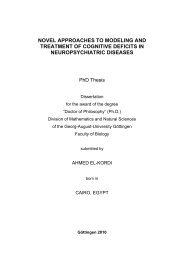Cortical and subcortical mechanisms in persistent stuttering ...
Cortical and subcortical mechanisms in persistent stuttering ...
Cortical and subcortical mechanisms in persistent stuttering ...
Create successful ePaper yourself
Turn your PDF publications into a flip-book with our unique Google optimized e-Paper software.
Introduction<br />
Fluent speech requires the well timed selection, <strong>in</strong>itiation, execution <strong>and</strong> monitor<strong>in</strong>g of motor<br />
sequences. The relevant cortical <strong>and</strong> <strong>subcortical</strong> neural systems appear to be malfunction<strong>in</strong>g<br />
<strong>in</strong> developmental stutter<strong>in</strong>g (Brown et al., 2005; Fox et al., 1996; Ludlow <strong>and</strong> Loucks, 2003).<br />
Stutter<strong>in</strong>g is characterized by an impairment of speech rhythm or fluency (Bloodste<strong>in</strong> <strong>and</strong><br />
Ratner, 2008). Speech disruptions typically <strong>in</strong>clude blocks, repetitions, or prolongations of<br />
speech segments ((WHO), 2007a), <strong>and</strong> may be accompanied by movements of face <strong>and</strong> limb<br />
muscles <strong>and</strong> by negative emotions such as fear or embarrassment. About 5% of the population<br />
stutters at some po<strong>in</strong>t dur<strong>in</strong>g childhood (Mansson, 2000). Although spontaneous recovery rate<br />
is high, stutter<strong>in</strong>g without obvious neurological orig<strong>in</strong> persists after puberty <strong>in</strong> about 1% of<br />
adults (Andrews <strong>and</strong> Harris, 1964; Bloodste<strong>in</strong> <strong>and</strong> Ratner, 2008; Craig et al., 2002). Explor<strong>in</strong>g<br />
the underly<strong>in</strong>g neural <strong>mechanisms</strong> of this disorder provides <strong>in</strong>sights <strong>in</strong>to <strong>mechanisms</strong> of<br />
dysfluent speech production <strong>and</strong> <strong>in</strong>to models of speech plann<strong>in</strong>g <strong>and</strong> production <strong>in</strong> general.<br />
These <strong>in</strong>sights <strong>in</strong>to the physiology of stutter<strong>in</strong>g may ultimately serve to improve treatments<br />
enhanc<strong>in</strong>g speech fluency.<br />
Temporal patterns <strong>in</strong> speech occur on multiple timescales (i.e. subsegmental, segmental <strong>and</strong><br />
suprasegmental, (Levelt, 1989c). In adults who stutter (AWS), acoustic-temporal <strong>and</strong> spatiotemporal<br />
characteristics are affected <strong>in</strong> stuttered <strong>and</strong> fluent speech on all these time scales<br />
(Jancke, 1994; Kle<strong>in</strong>ow <strong>and</strong> Smith, 2000; Max <strong>and</strong> Gracco, 2005; Pr<strong>in</strong>s <strong>and</strong> Hubbard, 1992).<br />
Most consistent are the observations of <strong>in</strong>creased variability of duration <strong>and</strong> relative tim<strong>in</strong>g of<br />
acoustic <strong>and</strong> k<strong>in</strong>ematic features. Additionally, stutter<strong>in</strong>g has been associated with altered<br />
auditory feedback control <strong>mechanisms</strong> (Max et al., 2004; Tourville et al., 2008). Altogether,<br />
these facts underl<strong>in</strong>e a deficit of speech motor tim<strong>in</strong>g <strong>and</strong> the impact of the tim<strong>in</strong>g of auditory<br />
<strong>in</strong>formation dur<strong>in</strong>g speak<strong>in</strong>g <strong>in</strong> AWS.<br />
Alterations of tim<strong>in</strong>g abilities <strong>in</strong> AWS exceed the doma<strong>in</strong> of speech <strong>and</strong> affect the motor<br />
control of non-speech movements as well. For example, AWS performed poorly <strong>in</strong><br />
reproduc<strong>in</strong>g vary<strong>in</strong>g rhythmic patterns (Hunsley, 1937) or unpredictable digit sequences<br />
(Webster, 1986). Additionally, AWS exhibit prolonged <strong>in</strong>itiation <strong>and</strong> execution times <strong>in</strong><br />
f<strong>in</strong>ger movement sequenc<strong>in</strong>g tasks (Smits-B<strong>and</strong>stra et al., 2006; Webster, 1997) <strong>and</strong> <strong>in</strong>creased<br />
manual reaction times (Bishop et al., 1991; Webster <strong>and</strong> Ryan, 1991). Phase variability is<br />
greater dur<strong>in</strong>g bimanual coord<strong>in</strong>ation of auditory paced movements (Zelaznik et al., 1997)<br />
<strong>and</strong> movement variability is <strong>in</strong>creased dur<strong>in</strong>g simultaneous synchronization of speech <strong>and</strong><br />
h<strong>and</strong> movements (Hulstijn et al., 1992). However, studies on auditory paced isochronous<br />
f<strong>in</strong>ger movements did not f<strong>in</strong>d differences of tim<strong>in</strong>g accuracy <strong>and</strong> tim<strong>in</strong>g variability between<br />
34



